
Distribution by demographic
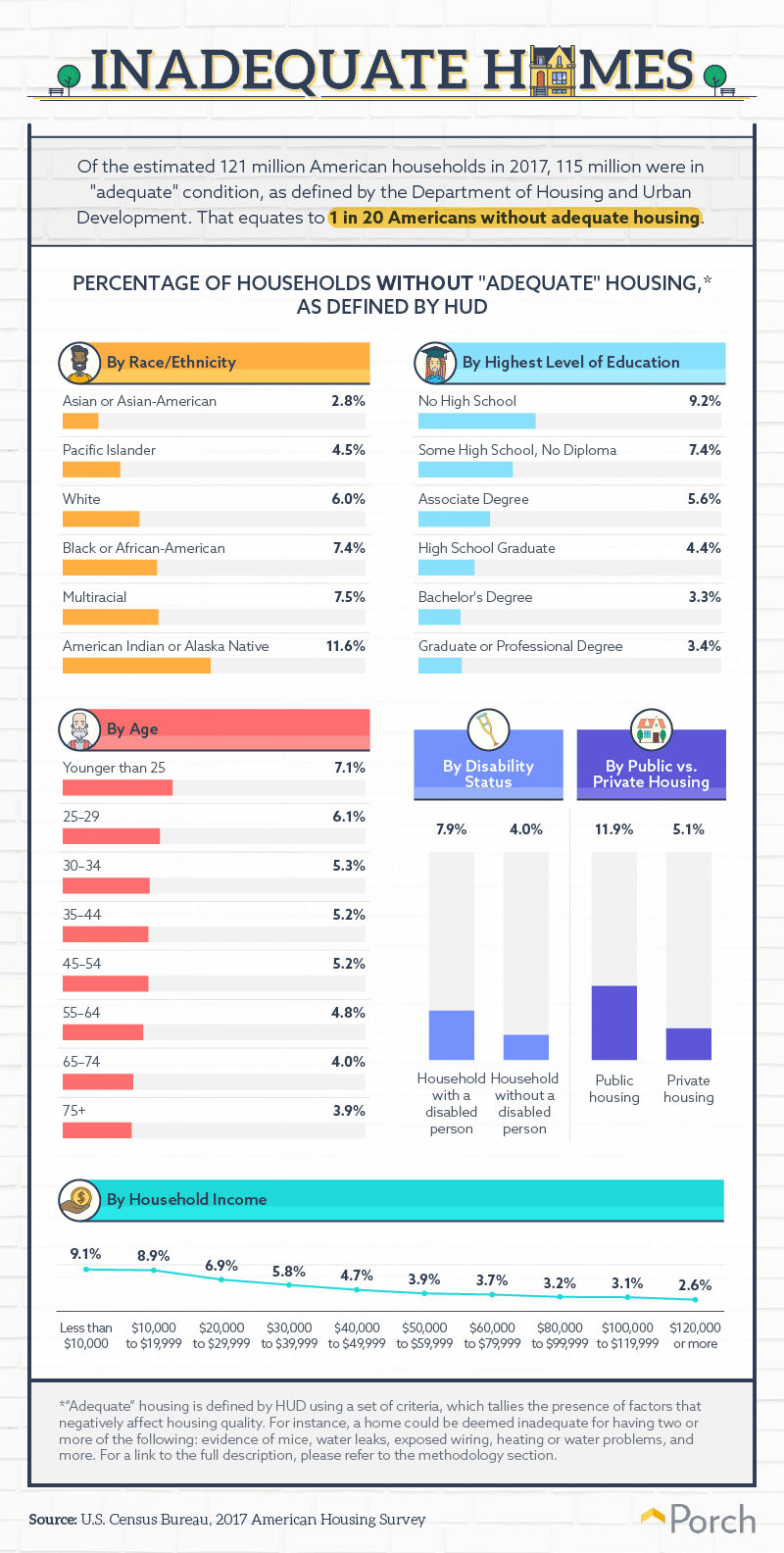 Our analysis indicates that roughly 5 percent of Americans live in homes that fail to meet Department of Housing and Urban Development (HUD) standards for “adequate” housing conditions. Yet, some racial or ethnic minorities are tragically overrepresented in this category. Nearly 12 percent of American Indians reside in inadequate housing, for example; structures on tribal lands are often in disrepair due to scarce funding for maintenance. Black and multiracial individuals were also more likely to live in inadequate homes, perhaps as a result of America’s deep history of housing discrimination. Those with lower levels of educational attainment were also more likely than average to live in difficult housing conditions. Individuals without a high school degree tend to earn less and, thus, have fewer affordable options. In fact, lower-income families may only be able to afford public housing, which is highly associated with poor living conditions in our data. In recent years, the percentage of HUD properties failing health and safety inspections has risen sharply—including among Section 8 properties, for which private landlords receive government funding.
Our analysis indicates that roughly 5 percent of Americans live in homes that fail to meet Department of Housing and Urban Development (HUD) standards for “adequate” housing conditions. Yet, some racial or ethnic minorities are tragically overrepresented in this category. Nearly 12 percent of American Indians reside in inadequate housing, for example; structures on tribal lands are often in disrepair due to scarce funding for maintenance. Black and multiracial individuals were also more likely to live in inadequate homes, perhaps as a result of America’s deep history of housing discrimination. Those with lower levels of educational attainment were also more likely than average to live in difficult housing conditions. Individuals without a high school degree tend to earn less and, thus, have fewer affordable options. In fact, lower-income families may only be able to afford public housing, which is highly associated with poor living conditions in our data. In recent years, the percentage of HUD properties failing health and safety inspections has risen sharply—including among Section 8 properties, for which private landlords receive government funding.
Urban America: comparing major cities
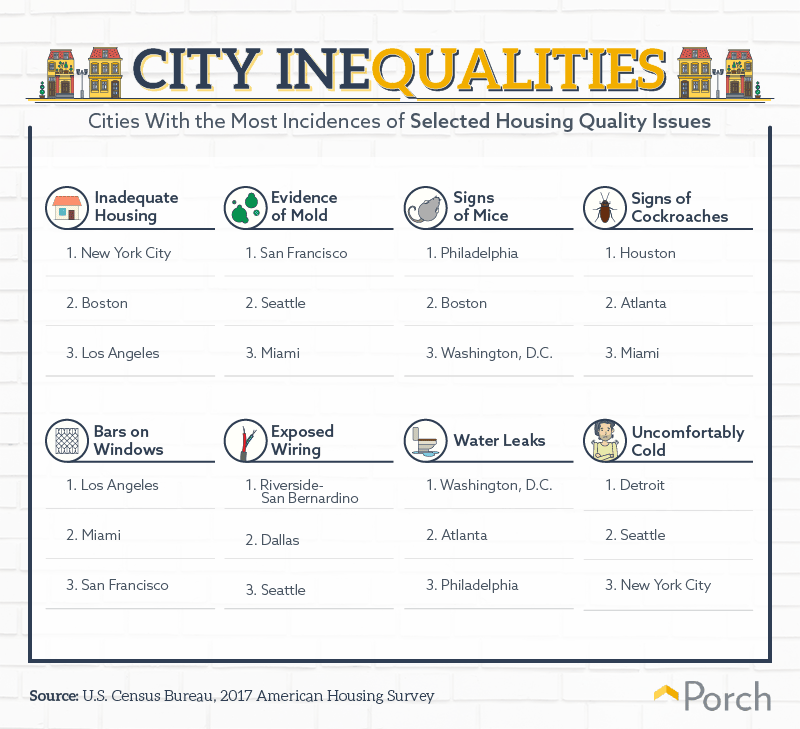 No American city boasts immaculate housing stock, but some urban centers have particularly urgent problems. In New York, where safety issues in public housing have attracted intense scrutiny, roughly 7 percent of residences were inadequate in some way. Many of the cities with the highest rates of inadequate housing also have exorbitant costs of living: New York, Boston, and Los Angeles are some of the nation’s most expensive locations. With rents in these cities reaching record highs, troubled housing may be the only affordable option for many residents. Some cities seemed especially prone to certain problems: In Houston, for example, 44 percent of residences saw signs of cockroaches during the previous year (although other Southern cities with warm weather had high rates as well). Conversely, mice sightings were more frequent in Northeastern cities, such as Boston and Philadelphia. However unpleasant these pests may seem, other places had perhaps a more dire problem: a high percentage of residences without adequate heat. In Detroit, where subzero temperatures are a common occurrence, 15 percent of homes were uncomfortably cold for at least 24 hours.
No American city boasts immaculate housing stock, but some urban centers have particularly urgent problems. In New York, where safety issues in public housing have attracted intense scrutiny, roughly 7 percent of residences were inadequate in some way. Many of the cities with the highest rates of inadequate housing also have exorbitant costs of living: New York, Boston, and Los Angeles are some of the nation’s most expensive locations. With rents in these cities reaching record highs, troubled housing may be the only affordable option for many residents. Some cities seemed especially prone to certain problems: In Houston, for example, 44 percent of residences saw signs of cockroaches during the previous year (although other Southern cities with warm weather had high rates as well). Conversely, mice sightings were more frequent in Northeastern cities, such as Boston and Philadelphia. However unpleasant these pests may seem, other places had perhaps a more dire problem: a high percentage of residences without adequate heat. In Detroit, where subzero temperatures are a common occurrence, 15 percent of homes were uncomfortably cold for at least 24 hours.
Minding mold
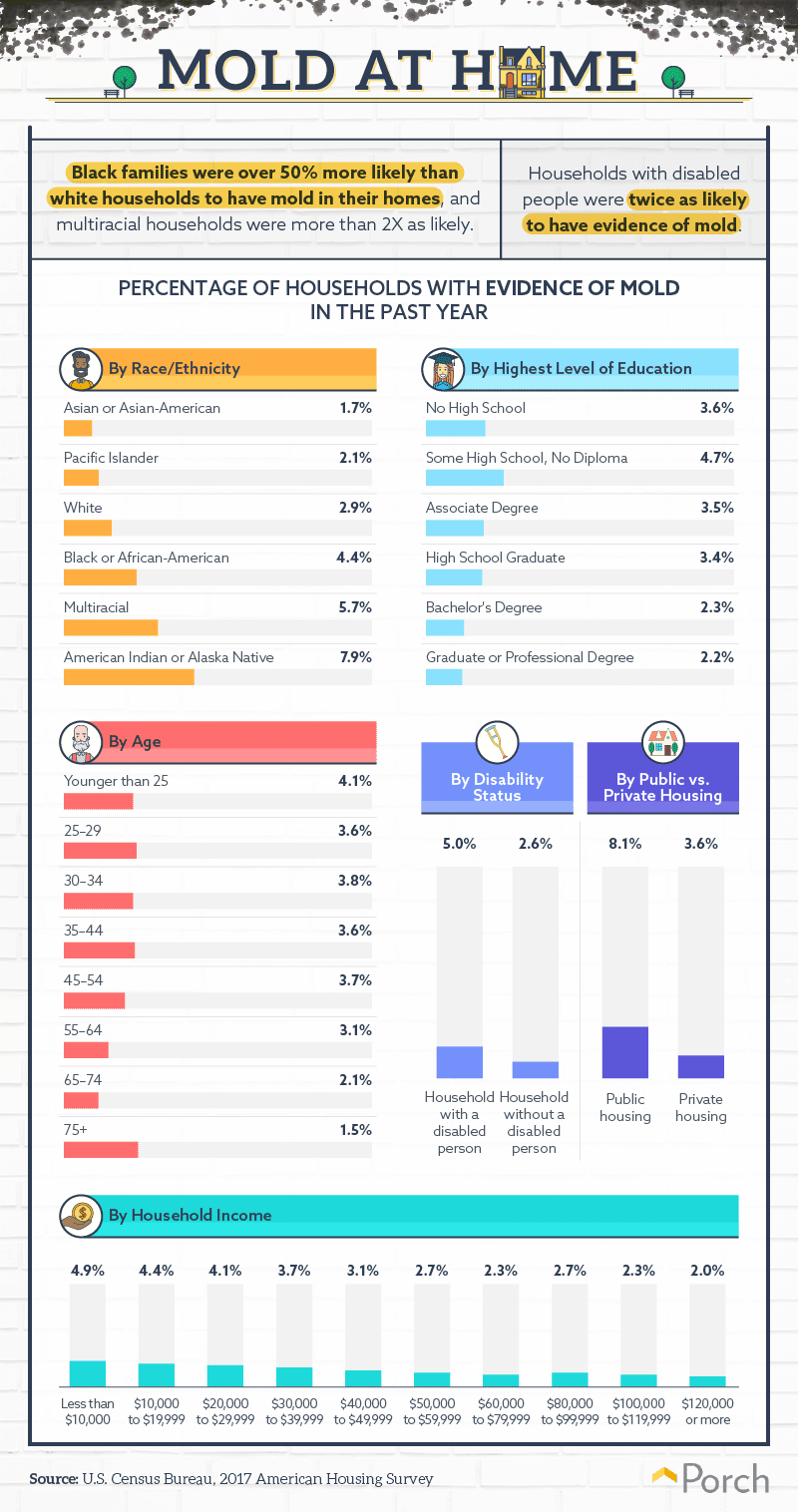 Mold is more than unsightly: Exposure can lead to respiratory issues, especially for those with allergies or asthma. Relative to Asian-American and white residents, black, multiracial, and American Indian individuals were especially likely to find mold at home. In fact, experts assert that indoor allergens such as mold contribute to higher asthma rates among African-Americans. Economic disparities were similarly obvious: The odds of having mold in one’s home seemed inversely correlated with income. While less than 4 percent of private homes had mold, that rate doubled for public housing properties. In recent years, critics have characterized HUD’s inspection system as too lenient in this regard: Buildings rife with toxic mold have been approved for residents to move in. Equally disturbing is the prevalence of mold in households where at least one resident has a disability. Residences of this type were almost twice as likely to have mold than in homes where no individual with a disability resided.
Mold is more than unsightly: Exposure can lead to respiratory issues, especially for those with allergies or asthma. Relative to Asian-American and white residents, black, multiracial, and American Indian individuals were especially likely to find mold at home. In fact, experts assert that indoor allergens such as mold contribute to higher asthma rates among African-Americans. Economic disparities were similarly obvious: The odds of having mold in one’s home seemed inversely correlated with income. While less than 4 percent of private homes had mold, that rate doubled for public housing properties. In recent years, critics have characterized HUD’s inspection system as too lenient in this regard: Buildings rife with toxic mold have been approved for residents to move in. Equally disturbing is the prevalence of mold in households where at least one resident has a disability. Residences of this type were almost twice as likely to have mold than in homes where no individual with a disability resided.
Insect invasion
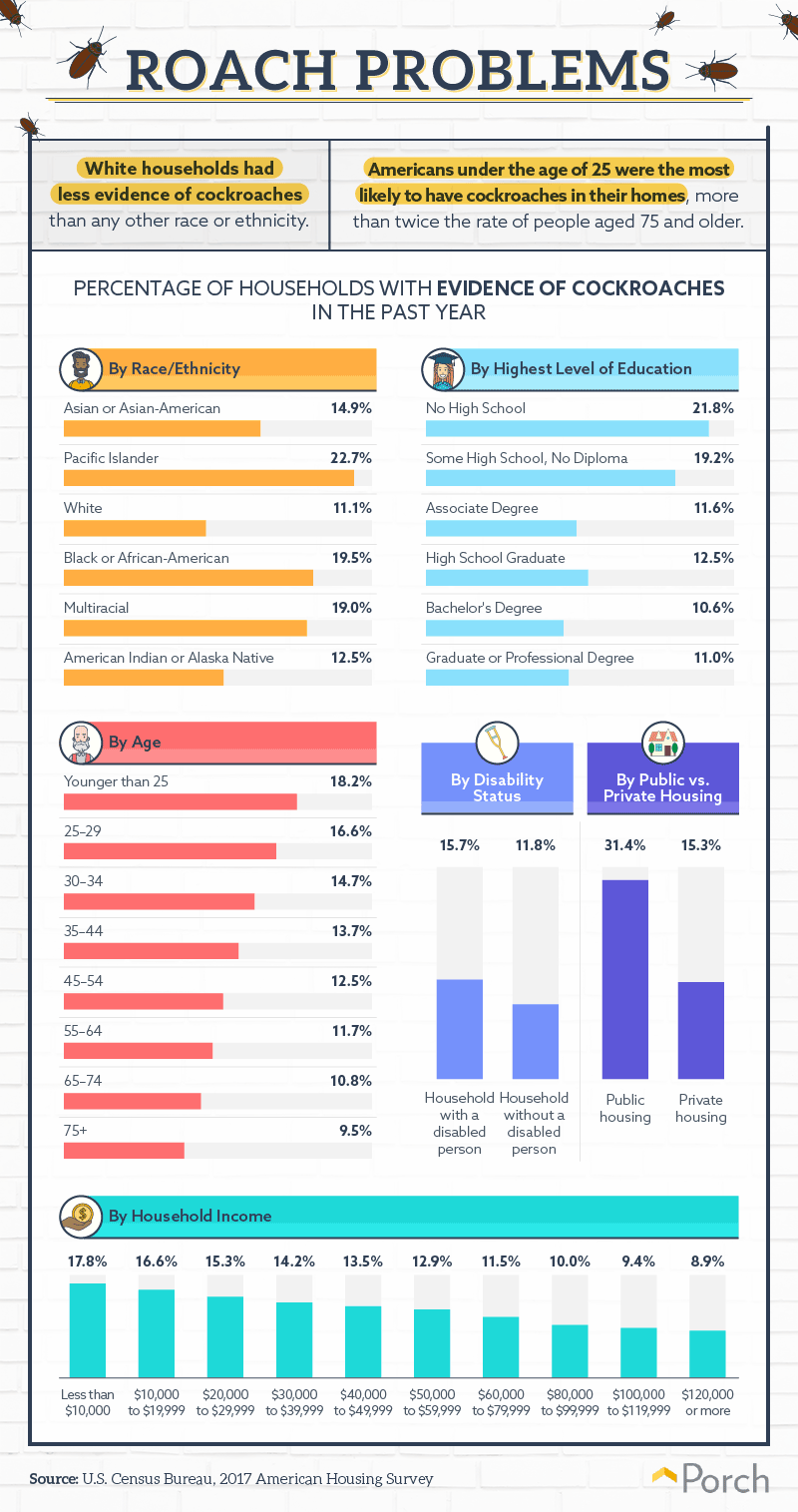 Cockroaches are a deeply unsettling presence in any home and frustratingly resistant to extermination. Pacific Islanders had the unfortunate distinction of being the ethnic group most likely to endure a cockroach infestation, followed by black and multiracial households. Those without a high school degree were more likely to have roaches at home, as were those with lower incomes. Additionally, older Americans seemed relatively skilled in keeping these bugs away, whereas 18 percent of individuals younger than 25 observed evidence of roaches in their residence. While experts say cleanliness is the best form of cockroach prevention, keeping things spick-and-span may be additionally difficult for those with a physical disability. Perhaps, as a result, households with disabled residents were more likely to have seen proof of roaches recently. Additionally, 31 percent of public housing residents witnessed evidence of cockroaches, compared to just 15 percent of those living in private properties. This finding may reflect the structure of public housing: In large apartment buildings, roaches can migrate between units through vents and gaps in the walls.
Cockroaches are a deeply unsettling presence in any home and frustratingly resistant to extermination. Pacific Islanders had the unfortunate distinction of being the ethnic group most likely to endure a cockroach infestation, followed by black and multiracial households. Those without a high school degree were more likely to have roaches at home, as were those with lower incomes. Additionally, older Americans seemed relatively skilled in keeping these bugs away, whereas 18 percent of individuals younger than 25 observed evidence of roaches in their residence. While experts say cleanliness is the best form of cockroach prevention, keeping things spick-and-span may be additionally difficult for those with a physical disability. Perhaps, as a result, households with disabled residents were more likely to have seen proof of roaches recently. Additionally, 31 percent of public housing residents witnessed evidence of cockroaches, compared to just 15 percent of those living in private properties. This finding may reflect the structure of public housing: In large apartment buildings, roaches can migrate between units through vents and gaps in the walls.
Rodent residents
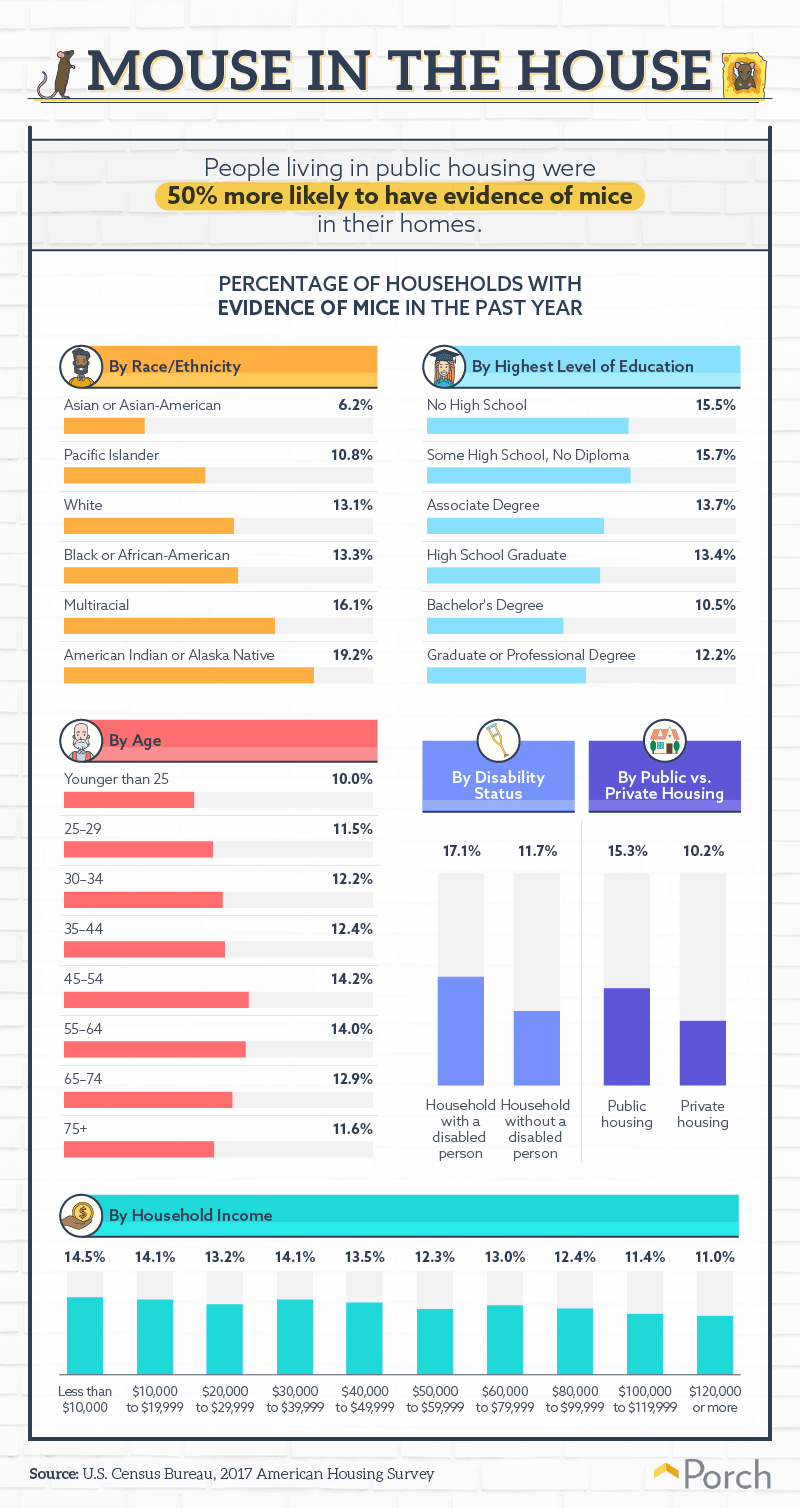 Mice often carry serious diseases, and their droppings can exacerbate the symptoms of people with allergies or asthma. Accordingly, it’s unfortunate that some ethnic groups have quite high rates of infestation: Nearly 1 in 5 American Indian households saw evidence of mice in the year prior. Additionally, unlike mold and roaches, mice were especially likely to be found in the homes of middle-aged individuals. Fourteen percent of individuals between the ages of 45 and 64 saw evidence of these vermin over the last 12 months. As with other housing issued studied, mice were more likely to appear in public housing than in private properties. In recent years, some cities have faced an even more disturbing rodent menace in their public housing units: Rats have appeared in housing projects in New York and Baltimore, even biting residents in some instances. Households with residents with disabilities were also more likely to have mice; sadly, these vermin could cause additional illness to residents with existing health issues.
Mice often carry serious diseases, and their droppings can exacerbate the symptoms of people with allergies or asthma. Accordingly, it’s unfortunate that some ethnic groups have quite high rates of infestation: Nearly 1 in 5 American Indian households saw evidence of mice in the year prior. Additionally, unlike mold and roaches, mice were especially likely to be found in the homes of middle-aged individuals. Fourteen percent of individuals between the ages of 45 and 64 saw evidence of these vermin over the last 12 months. As with other housing issued studied, mice were more likely to appear in public housing than in private properties. In recent years, some cities have faced an even more disturbing rodent menace in their public housing units: Rats have appeared in housing projects in New York and Baltimore, even biting residents in some instances. Households with residents with disabilities were also more likely to have mice; sadly, these vermin could cause additional illness to residents with existing health issues.
Wiring risk
 While local building codes differ slightly, there are stringent national regulations intended to keep electrical wiring away from places in which it might be damaged or exposed. And perhaps because electrical inspections are a standard part of the home construction process, relatively few Americans live in homes with exposed wiring. Our data did reflect the impact of privilege to some extent, however. Exposed wiring was particularly unlikely to appear in the homes of the white, wealthy, and well-educated. Interestingly, exposed wiring was less likely to be present in public housing than in private homes. This finding could simply reflect the impact of occasional visits from HUD inspectors: In private homes, conversely, wiring isn’t subjected to such regular scrutiny. Unfortunately, however, homes with disabled residents were slightly more likely to have these wiring issues. As smart home technology radically alters the way people with disabilities navigate their homes, the safe installation of any additional wiring should be a top priority.
While local building codes differ slightly, there are stringent national regulations intended to keep electrical wiring away from places in which it might be damaged or exposed. And perhaps because electrical inspections are a standard part of the home construction process, relatively few Americans live in homes with exposed wiring. Our data did reflect the impact of privilege to some extent, however. Exposed wiring was particularly unlikely to appear in the homes of the white, wealthy, and well-educated. Interestingly, exposed wiring was less likely to be present in public housing than in private homes. This finding could simply reflect the impact of occasional visits from HUD inspectors: In private homes, conversely, wiring isn’t subjected to such regular scrutiny. Unfortunately, however, homes with disabled residents were slightly more likely to have these wiring issues. As smart home technology radically alters the way people with disabilities navigate their homes, the safe installation of any additional wiring should be a top priority.
Protection or peril?
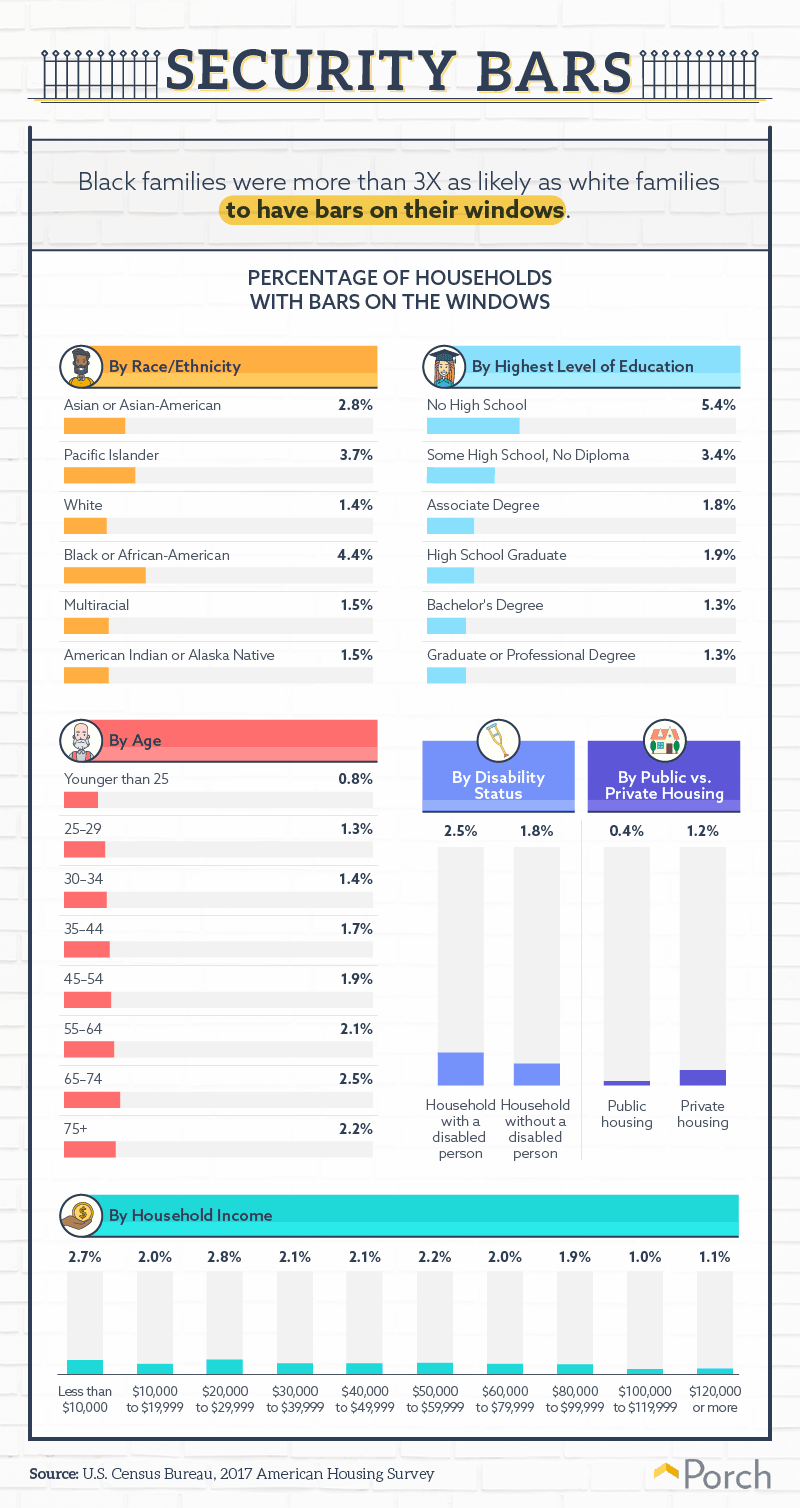 Bars installed across windows can create a grim impression, but they are associated with real safety risks as well. As authorities have noted in recent decades, these security bars can prevent residents from fleeing in the event of a fire, trapping them inside. Thankfully, fewer than 5 percent of each ethnic group still had these bars installed on their windows, although they were most prevalent among black Americans and Pacific Islanders. Beyond fire safety concerns, security bars may have fallen out of fashion for a more fundamental reason. Since the 1990s, rates of property crimes have declined significantly, reducing the need for such overt defenses around one’s home. This development may explain why young people were particularly unlikely to have them on their windows, whereas older Americans may recall a time when they seemed necessary. Or perhaps younger people simply gravitate toward high-tech alternatives, like smart home security systems.
Bars installed across windows can create a grim impression, but they are associated with real safety risks as well. As authorities have noted in recent decades, these security bars can prevent residents from fleeing in the event of a fire, trapping them inside. Thankfully, fewer than 5 percent of each ethnic group still had these bars installed on their windows, although they were most prevalent among black Americans and Pacific Islanders. Beyond fire safety concerns, security bars may have fallen out of fashion for a more fundamental reason. Since the 1990s, rates of property crimes have declined significantly, reducing the need for such overt defenses around one’s home. This development may explain why young people were particularly unlikely to have them on their windows, whereas older Americans may recall a time when they seemed necessary. Or perhaps younger people simply gravitate toward high-tech alternatives, like smart home security systems.
Damaging drips
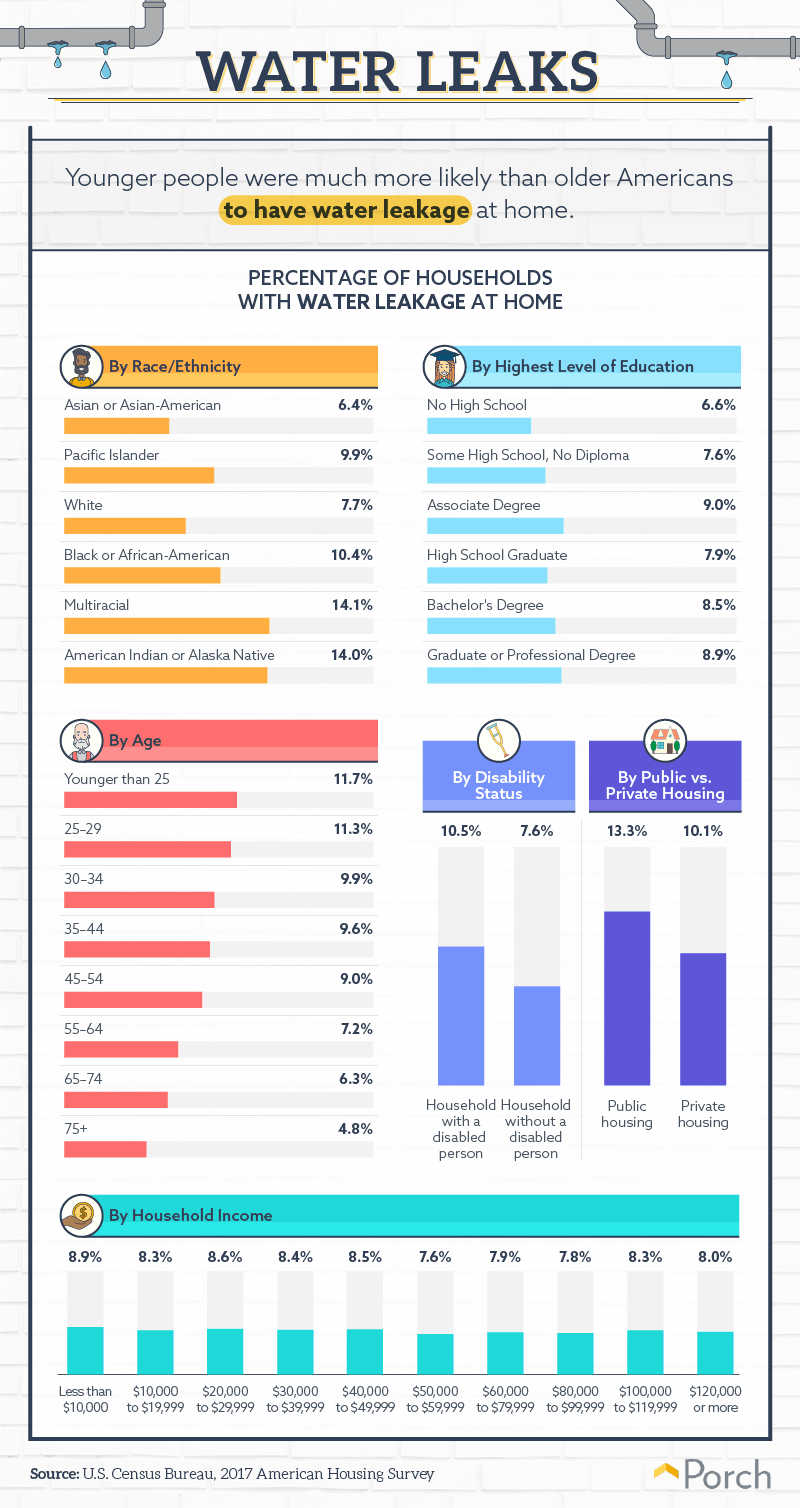 Water damage in homes is often associated with leaky roofs or flooding in the wake of a storm. But internal leaks can also necessitate costly repairs: Pipes can burst in winter, or water heaters can break down, causing lasting damage. Multiracial and American Indian individuals were especially likely to experience this kind of leak in their homes. Younger people were also likely to live with such leaks, which may reflect their tendency to rent rather than own. When you’re a homeowner, you can fix leaks immediately to protect your investment, whereas renters depend on landlords to intervene. Water leakage was more common in public housing than in private residences. Although leaks in housing projects are concerning in their own right, critics point out that faulty pipes eventually produce a more serious threat: mold. Water leakage also appeared more often in the homes of people with disabilities. Interestingly, however, higher incomes did not necessarily correspond to a lack of leaks at home, and highly educated people actually experienced leaks more frequently.
Water damage in homes is often associated with leaky roofs or flooding in the wake of a storm. But internal leaks can also necessitate costly repairs: Pipes can burst in winter, or water heaters can break down, causing lasting damage. Multiracial and American Indian individuals were especially likely to experience this kind of leak in their homes. Younger people were also likely to live with such leaks, which may reflect their tendency to rent rather than own. When you’re a homeowner, you can fix leaks immediately to protect your investment, whereas renters depend on landlords to intervene. Water leakage was more common in public housing than in private residences. Although leaks in housing projects are concerning in their own right, critics point out that faulty pipes eventually produce a more serious threat: mold. Water leakage also appeared more often in the homes of people with disabilities. Interestingly, however, higher incomes did not necessarily correspond to a lack of leaks at home, and highly educated people actually experienced leaks more frequently.
Intolerable temperatures
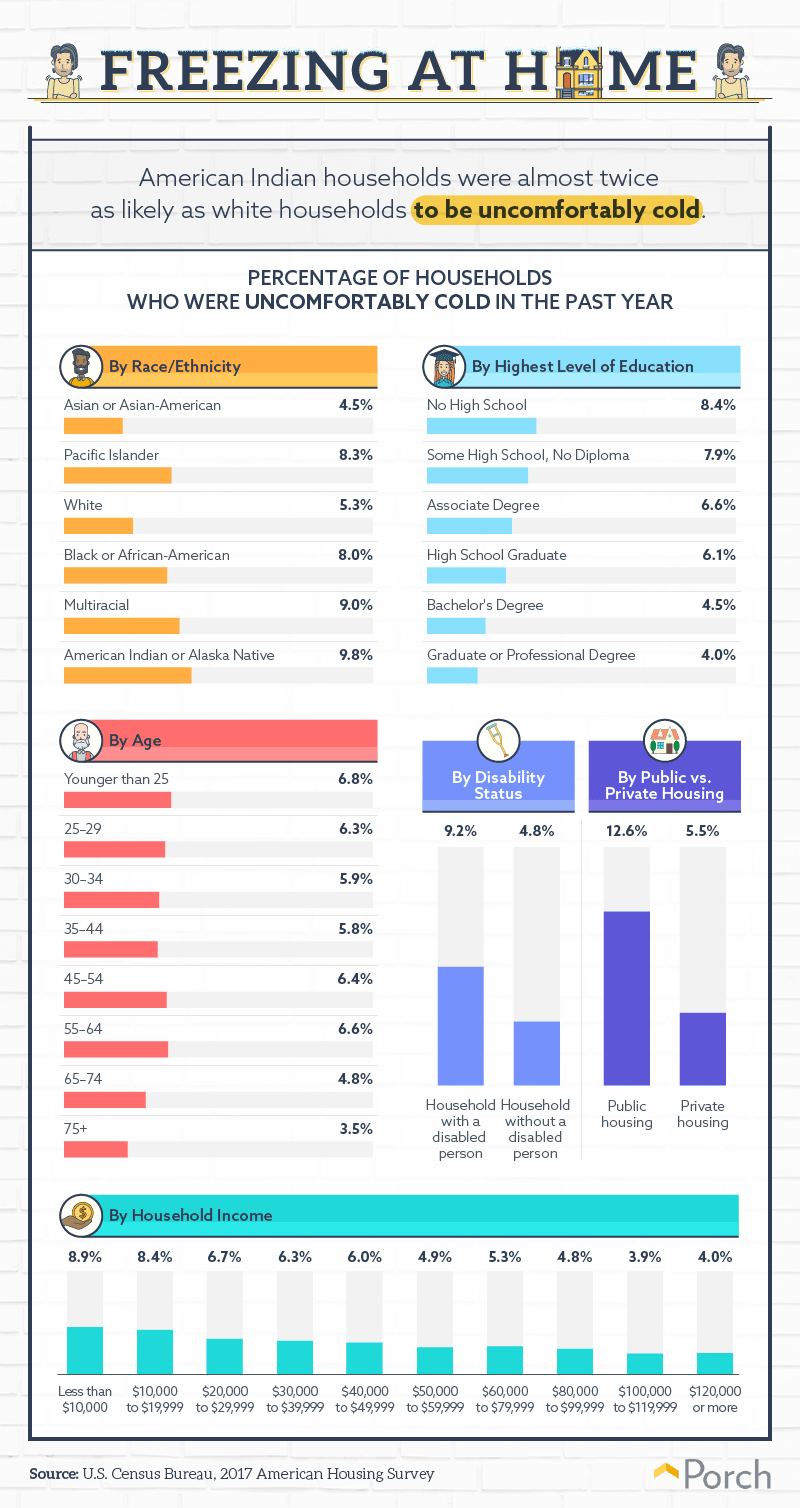 In a nation where nearly a third of households have difficulty affording their energy bills, it’s no surprise that a significant percentage of homes are uncomfortably cold. Unfortunately, large racial disparities emerged in terms of access to heat: White and Asian-American individuals were far less likely to deal with uncomfortable cold at home than other ethnic groups. Additionally, low-income Americans were more likely than wealthy individuals to face uncomfortable temperatures. Thankfully, federal programs do exist to help families keep the heat on in times of financial need, although funding is limited. Additionally, relatively few individuals aged 65 and older had uncomfortably cold homes. This finding is encouraging because older adults face an increased risk of hypothermia. Residents of public housing did not fare so well: Nearly 13 percent had uncomfortably cold housing. In some high-profile cases, a lack of heat in public housing has led to widespread rage, such as when thousands of residents went without heat over Thanksgiving in New York City’s projects.
In a nation where nearly a third of households have difficulty affording their energy bills, it’s no surprise that a significant percentage of homes are uncomfortably cold. Unfortunately, large racial disparities emerged in terms of access to heat: White and Asian-American individuals were far less likely to deal with uncomfortable cold at home than other ethnic groups. Additionally, low-income Americans were more likely than wealthy individuals to face uncomfortable temperatures. Thankfully, federal programs do exist to help families keep the heat on in times of financial need, although funding is limited. Additionally, relatively few individuals aged 65 and older had uncomfortably cold homes. This finding is encouraging because older adults face an increased risk of hypothermia. Residents of public housing did not fare so well: Nearly 13 percent had uncomfortably cold housing. In some high-profile cases, a lack of heat in public housing has led to widespread rage, such as when thousands of residents went without heat over Thanksgiving in New York City’s projects.
Empowering improvement
As our findings repeatedly indicate, housing conditions reflect broader differences in economic opportunity. Just as some minorities and people with disabilities are disproportionately likely to experience poverty, so too are they more likely to occupy inadequate housing. Moreover, the condition of public housing seems to reinforce these inequalities, rather than resolve them. When it comes to creating safe and affordable housing, opinions differ considerably with regard to effective policy measures. Yet, there must first be consensus on the scale of the challenge at hand: Every day, millions of Americans risk harm in their own homes. Unfortunately, even those who own their homes often put off necessary repairs, leading to lasting damage or danger. But homeowners may find that meaningful improvements are more affordable than they imagine—if they can find a trustworthy professional willing to provide a reasonable quote. Porch facilitates those connections for Americans across the country. Our platform links experienced professionals with homeowners who need their services from tv mounting to window replacement. Try us for free today to get competitive quotes with no obligation at all.
Methodology and limitations
The data shown above were compiled using the U.S. Census Bureau’s 2017 American Housing Survey (AHS). All figures are estimates and provided by the Census Bureau and may have margins of error associated with them. For more information on the American Housing Survey, the accuracy of the data, and definitions, please see the American Housing Survey website. With respect to the definition of housing adequacy, please see the AHS’s definitions and table index.
Sources
- https://www.huffingtonpost.com/entry/housing-crisis-inequality-harvard-report_us_5b27c1f1e4b056b2263c621e
- https://www.healthypeople.gov/2020/topics-objectives/topic/social-determinants-health/interventions-resources/quality-of-housing
- https://www.census.gov/programs-surveys/ahs.html
- https://www.americamagazine.org/politics-society/2018/02/05/indian-reservations-are-poor-conditions-show-no-signs-improvement
- https://www.usnews.com/news/the-report/articles/2018-04-20/us-is-still-segregated-even-after-fair-housing-act
- https://www.bls.gov/emp/chart-unemployment-earnings-education.htm
- https://www.nbcnews.com/politics/white-house/under-ben-carson-more-families-live-hud-housing-fails-health-n935421
- https://www.epa.gov/mold/ten-things-you-should-know-about-mold
- https://www.aafa.org/asthma-facts/
- https://www.propublica.org/article/hud-inspections-pass-dangerous-apartments-with-rats-roaches-toxic-mold
- https://www.goodhousekeeping.com/home/cleaning/a35872/how-to-get-rid-of-mice/
- https://www.nbcnewyork.com/news/local/Rats-Take-Over-Apartments-Bronx-New-York-City-Public-Housing-497638621.html
- https://wtop.com/baltimore/2018/12/housing-authority-says-baltimore-rat-population-down-in-public-housing/
- https://www.thespruce.com/romex-and-conduit-wiring-in-exposed-locations-1821529
- https://www.thespruce.com/electrical-inspector-checkpoints-1152283
- https://www.nbcnews.com/politics/white-house/hud-weighs-tougher-inspections-public-housing-after-nbc-news-report-n950161
- https://nypost.com/2018/07/30/smart-homes-are-game-changers-for-people-with-disabilities/
- https://www.npr.org/2018/09/19/649633468/31-percent-of-u-s-households-have-trouble-paying-energy-bills
- https://www.acf.hhs.gov/ocs/resource/liheap-fact-sheet-0
- https://health.usnews.com/health-care/for-better/articles/2018-01-03/the-older-adults-guide-to-cold-weather
- https://www.wnyc.org/story/public-housing-residents-suffer-without-heat-over-thanksgiving-weekend/
- https://www.usatoday.com/story/money/economy/2018/10/10/faces-poverty-social-racial-factors/37977173/
Fair use statement
Whether you’re thrilled with your own home, we could all use a reminder that many American families face difficult housing conditions every day. Feel free to share this content with your friends and family, but please do so only for noncommercial purposes. Also, include a link back to this page wherever you post this project so that others can see all our findings.
